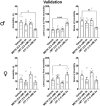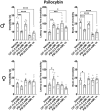Validation of the forced swim test in Drosophila, and its use to demonstrate psilocybin has long-lasting antidepressant-like effects in flies
- PMID: 35705666
- PMCID: PMC9200711
- DOI: 10.1038/s41598-022-14165-2
Validation of the forced swim test in Drosophila, and its use to demonstrate psilocybin has long-lasting antidepressant-like effects in flies
Abstract
Psilocybin has been shown to be a powerful, long-lasting antidepressant in human clinical trials and in rodent models. Although rodents have commonly been used to model psychiatric disorders, Drosophila have neurotransmitter systems similar to mammals and many comparable brain structures involved in similar behaviors. The forced swim test (FST), which has been used extensively to evaluate compounds for antidepressant efficacy, has recently been adapted for Drosophila. The fly FST has potential to be a cost-effective, high-throughput assay for evaluating potential antidepressants. For this study we pharmacologically validated the fly FST using methamphetamine, DL-α-methyltyrosine, and the antidepressant citalopram. While methamphetamine and DL-α-methyltyrosine altered overall locomotor activity in the Drosophila Activity Monitor System (DAMS), they had no significant impact on measures of immobility in the FST. Conversely, chronic citalopram decreased measures of immobility in the FST in both sexes without increasing DAMS activity. We used the validated FST to evaluate the antidepressant-like effects of high (3.5 mM) and low (0.03 mM) doses of psilocybin. Both doses of psilocybin significantly reduced measures of immobility in male flies, but not females. 0.03 mM had an effect size comparable to chronic citalopram, and 3.5 mM had an effect size approximately twice that of chronic citalopram.
© 2022. The Author(s).
Conflict of interest statement
M.H. has no competing interests. C.D. Nichols is a member of the Scientific Advisory Board of Eleusis Therapeutics, and has a Sponsored Research Contract with Eleusis Therapeutics.
Figures






Similar articles
-
Psilocybin has a narrow therapeutic window as an antidepressant treatment.Prog Neuropsychopharmacol Biol Psychiatry. 2025 Apr 2;138:111368. doi: 10.1016/j.pnpbp.2025.111368. Epub 2025 Apr 15. Prog Neuropsychopharmacol Biol Psychiatry. 2025. PMID: 40246053
-
Increased sensitivity to antidepressants of D3 dopamine receptor-deficient mice in the forced swim test (FST).Eur Neuropsychopharmacol. 2008 Apr;18(4):271-7. doi: 10.1016/j.euroneuro.2007.07.003. Epub 2007 Sep 4. Eur Neuropsychopharmacol. 2008. PMID: 17804207
-
Behavioral and pharmacological validation of the gerbil forced-swim test: effects of neurokinin-1 receptor antagonists.Neuropsychopharmacology. 2008 Jul;33(8):1919-28. doi: 10.1038/sj.npp.1301586. Epub 2007 Oct 3. Neuropsychopharmacology. 2008. PMID: 17912250
-
Forced swim test: What about females?Neuropharmacology. 2015 Dec;99:408-21. doi: 10.1016/j.neuropharm.2015.03.016. Epub 2015 Apr 1. Neuropharmacology. 2015. PMID: 25839894 Review.
-
Factors influencing behavior in the forced swim test.Physiol Behav. 2013 Jun 13;118:227-39. doi: 10.1016/j.physbeh.2013.05.012. Epub 2013 May 14. Physiol Behav. 2013. PMID: 23685235 Free PMC article. Review.
Cited by
-
Serotonin distinctly controls behavioral states in restrained and freely moving Drosophila.iScience. 2022 Dec 28;26(1):105886. doi: 10.1016/j.isci.2022.105886. eCollection 2023 Jan 20. iScience. 2022. PMID: 36654863 Free PMC article.
-
Behavioral and genetic analysis of the effects of the psychedelic 2,5-dimethoxy-4-iodoamphetamine (DOI) in C. elegans.PLoS One. 2025 Aug 26;20(8):e0329538. doi: 10.1371/journal.pone.0329538. eCollection 2025. PLoS One. 2025. PMID: 40857291 Free PMC article.
-
Identifying trends in reporting on the ethical treatment of insects in research.PLoS One. 2025 Aug 18;20(8):e0328931. doi: 10.1371/journal.pone.0328931. eCollection 2025. PLoS One. 2025. PMID: 40824963 Free PMC article.
-
The effects of Lysergic Acid Diethylamide (LSD) on the Positive Valence Systems: A Research Domain Criteria (RDoC)-Informed Systematic Review.CNS Drugs. 2023 Dec;37(12):1027-1063. doi: 10.1007/s40263-023-01044-1. Epub 2023 Nov 24. CNS Drugs. 2023. PMID: 37999867 Free PMC article.
-
Preadministration of Lorazepam Reduces Efficacy and Longevity of Antidepressant-Like Effect from a Psychedelic.Psychedelic Med (New Rochelle). 2024 Mar 12;2(1):10-14. doi: 10.1089/psymed.2023.0037. eCollection 2024 Mar. Psychedelic Med (New Rochelle). 2024. PMID: 40051761 Free PMC article.
References
-
- O’Kane, C. J. Drosophila as a model organism for the study of neuropsychiatric disorders. in Molecular and Functional Models in Neuropsychiatry. 37–60. 10.1007/7854_2010_110 (Springer, 2011). - PubMed
Publication types
MeSH terms
Substances
Grants and funding
LinkOut - more resources
Full Text Sources
Medical
Molecular Biology Databases
Miscellaneous

